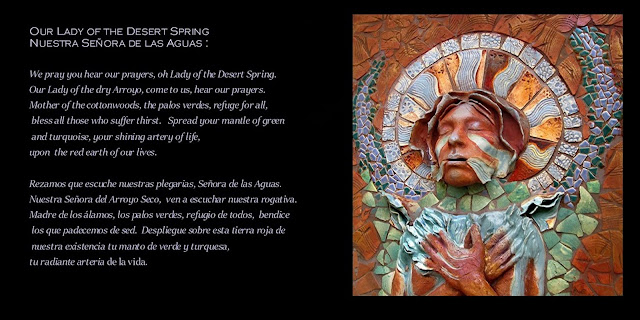 |
| "The Memory Keeper" and "Our Lady of the Forgotten Midwives" (2019) |
For quite a long time now I go into the studio faithfully just about every day, and I sit there, sometimes I fool around on the computer, mostly I look at all the terrifying blank white canvases or the neatly stacked bags of clay or the big pile of leather I have next to the plaster casts of faces, also neatly stacked and displayed on a shelf ...... then I go get some coffee, pat the cats, pull some weeds, check my email, and somehow, the day is pretty much gone and I haven't done anything. I wish I could say that I am an engine of new ideas and creativity these days, but I am not. I am, perhaps, dormant, incubational, etc. More of my own words coming back to haunt me.
 |
| "Our Lady of the Shards" (2013) |
So, at least, I can look back at this rather huge body of work(s) that surround me (and if I were wealthy I would have a gallery again, where I and others would have badly needed space to share our art, and we could do the teaching and community creation that an arts district provides)..... but, I don't live in a place where art districts are much valued, except by real estate developers. Tucson's so called "Art and Warehouse District", having once been lively, should now be called the "Fancy Wine Bar and Pretentious Restaurant" district, most of the galleries being now extinct. Well. If wishes were fishes.................
 |
| The Memory Keeper I (2018) |
I don't know about other artists, but I always have about 3 to 5 series of works going at a time, and can't really say where one series ends and another begins. Sometimes they begin with me just playing with a shape or a color, and the work itself tells me where it wants to go. Magical, that experience of "Flow". Stories themselves don't have an end, they just find new expressions - they become a "trilogy", or a side character demands attention because it has developed a voice, or there is an undiscovered country beyond the borders that has sent out an exploration party, etc. That is true in other art forms as well.
 |
| "The Weaver" (2018) |
 |
| The Bone Goddess (2018) |
I really love my continuing series of ceramic ICONS "Our Lady of the Shards" that evolved when I found myself staring at a pile of beautiful shards of broken pots from the Clay Coop where I sometimes work. They were half buried in the mound of recycled clay, and I thought of how archeologists might feel, sorting through the buried fragments of lives and cultures long lost, long buried, long forgotten. Piecing shards together like a jigsaw puzzle to find the stories and see again the hands that made those artifacts? How would it be, to see the faces of the forgotten rising from the buried past? And, for me, particularly the voices of the women, silenced in the long advance of "his-story" - the forgotten Midwives who brought our ancestors into the world, the Wise Women and the Weavers and Spinners of lives, the Goddesses cast aside in patriarchal monotheism? The tangible and communicative Spirits of Place, the "Numina", rising from the buried places, from the dry and broken soil of desert arroyos where they continue to sustain us, or revealed by a storm or a sudden flood. The Memory Keepers who keep the essential and sustaining stories, the "Water from Another Time" that generates and informs the present? Whether buried intentionally or not, these faces rise from the dreaming Earth, from the clay and the stone, their eyes opening as they wake again.
 |
| "Hecate" (2019) |
What might they look like? What might they tell us as we plunge into a future that seems so uncertain in the face of ecological and social crisis? I have been making works about "surfacing" for a long time. Along with my colleagues I reflect that some of us are "spiritual archeologists". Faces, Myths, Presence: surfacing from among the shards.
 |
| "The Black Madonna" (2019) |
 |
| "Our Lady of the Waters" (2014) |






























